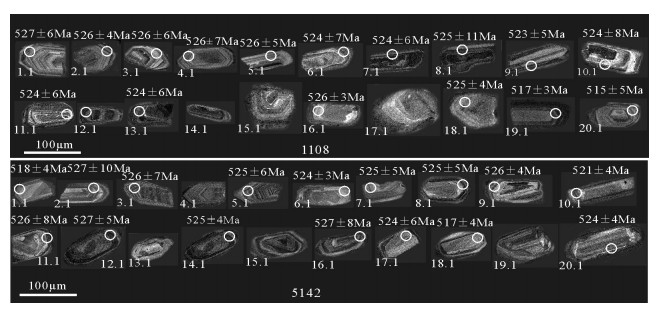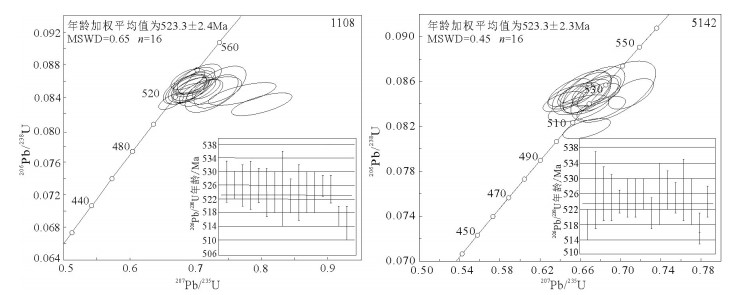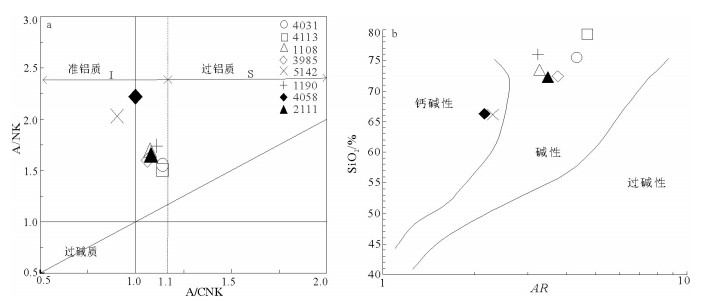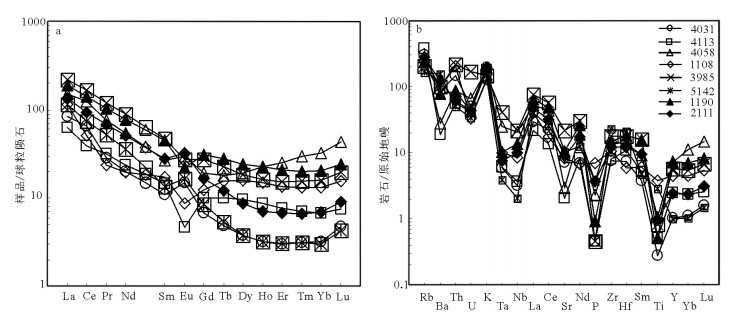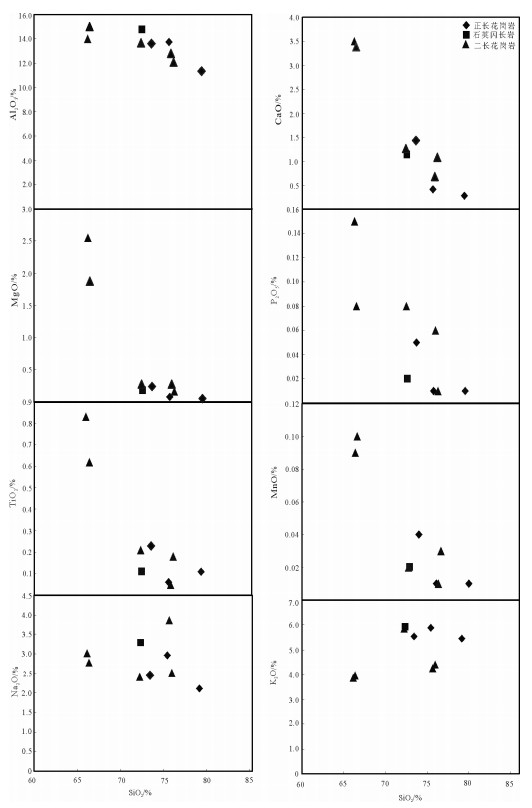U-Pb zircon age and geochemical characteristics of Early Paleozoic granites in the Baoqing area, Heilongjiang Province
-
摘要:
对黑龙江宝清地区七一林场正长花岗岩岩体、干涸沟口二长花岗岩进行了详细的地球化学分析和U-Pb锆石测年,结果表明,正长花岗岩与二长花岗岩的形成年龄分别为523.3±2.4Ma和523.3±2.3Ma,属于早寒武世。地球化学的研究显示,岩石具有准铝质-过铝质钙碱性碱性和高分异I型花岗岩的特点,高硅、高铝、富碱。属于轻稀土元素富集、重稀土元素亏损型;δEu=0.38~1.73,平均值为1.05,根据Eu的正负异常,将宝清地区的花岗岩分为2类,正Eu异常型花岗岩和负Eu异常型花岗岩。富集大离子亲石元素(LILE)Rb、K,亏损高场强元素(HFSE)Nb、Ta、P、Ti。结合区域构造背景与年代学特征,在早古代以前佳木斯-兴凯地块可能属于同一个大陆——冈瓦纳大陆,在泛非运动主峰期之后,由于陆块的碰撞,形成大量的早古生代花岗质岩石。
Abstract:Detailed geochemical analysis and U-Pb zircon dating were carried out for Qiyilinchang syenogranite and Ganhegoukou monzonitic granite in Baoqing area, Heilongjiang Province. The results show that the ages of the syenogranite and monzonitic granite are 523.3±2.4Ma and 523.3±2.3Ma respectively, implying early Cambrian. Petrogeochemical studies show that they have the features of quasi aluminous peraluminous calc alkaline and high differentiation Ⅰ-type granite with high silicon, high aluminum and rich alkali. They belong to the type of LREE enrichment and HREE depletion. δEu=0.38~1.73, averaging 1.05. According to positive and negative Eu anomalies, the granites in Baoqing area are divided into positive Eu anomaly granite and negative anomaly granite. They are enriched in large ion rock elements (LILE) Rb and K, and depleted in high field strength elements (HFSE) Nb, Ta, P and Ti. Combined with regional tectonic background and chronology, the authors hold that, before early Proterozoic, Jiamusi-Xingkai massif might have belonged to the same continent of Gondwana and then, after the peak period of the Pan African movement, due to the collision of continental blocks, large quantities of Early Paleozoic granitic rocks were formed.
-
Keywords:
- Jiamusi massif /
- syenogranite /
- monzonitic granite /
- LA-ICP-MS zircon U-Pb dating /
- geochemistry /
- tectonic setting
-
致谢: 黑龙江地球物理勘察院张树岐工程师在野外地质工作中提供帮助,成文过程中王立峰教授和王智慧博士给予悉心指导,中国地质大学(武汉)地质过程与矿产资源国家重点实验室对LA-ICP-MS锆石U-Pb测年工作给予支持,审稿专家对本文提出宝贵的修改意见,在此一并表示诚挚的感谢。
-
图 6 花岗质岩石球粒陨石标准化稀土元素配分图解(a)和原始地幔标准化蛛网图(b)(标准化数据据参考文献[38])
Figure 6. Chondrite-normalized REE patterns (a) and primitive mantle-normalized trace element spider diagram (b)
图 8 花岗质岩石(Yb+Ta)-Rb(a)和(Yb+Nb)-Rb(b)构造环境判别图[48]
ORG—大洋脊花岗岩;WPG—板内花岗岩;VAG—火山弧花岗岩;syn-COLG—同碰撞花岗岩
Figure 8. (Yb+Ta) versus Rb (a) and (Yb+Ta) versus Rb (b) discrimination diagrams of tectonic environment for granite rocks
表 1 正长花岗岩(1108)和二长花岗岩(5142)LA-ICP-MS单颗粒锆石U-Th-Pb同位素数据
Table 1 U-Th-Pb isotopic dating results for the single-grain zircon from syenogranite (1108) and monogranite(5142)
测点编号 含量/10-6 Th/U 同位素比值 年龄/Ma Pb U Th 206Pb/238U 1σ 207Pb/235U 1σ 207Pb/206Pb 1σ 208Pb/232Th 1σ 238U/232Th 1σ 206Pb/238U 1σ 207Pb/235U 1σ 207Pb/206Pb 1σ 1108 1.1 143 1468 393 0.27 0.0853 0.0011 0.6895 0.0182 0.0585 0.0016 0.0254 0.0006 3.85 0.04 527 6 533 11 547 36 2.1 118 1193 360 0.31 0.085 0.0007 0.6931 0.0161 0.0588 0.0014 0.026 0.0005 3.23 0.03 526 4 535 10 559 37 3.1 79 817 173 0.21 0.085 0.0011 0.6896 0.0203 0.0588 0.0018 0.0282 0.0009 4.63 0.05 526 6 533 12 560 42 4.1 124 1324 215 0.16 0.085 0.0011 0.6941 0.0149 0.0591 0.0012 0.0251 0.0007 6.13 0.06 526 7 535 9 569 25 5.1 107 1095 325 0.29 0.085 0.0008 0.7141 0.0157 0.0606 0.0012 0.0298 0.0006 3.32 0.03 526 5 547 9 624 31 6.1 109 1085 259 0.24 0.0847 0.0011 0.7217 0.0322 0.0618 0.0029 0.0261 0.0003 4.1 0.04 524 7 552 19 667 102 7.1 80 841 189 0.22 0.0847 0.001 0.6777 0.0159 0.0581 0.0015 0.0275 0.0008 4.34 0.04 524 6 525 10 535 31 8.1 53 564 142 0.25 0.0849 0.0019 0.7291 0.0299 0.0619 0.0021 0.028 0.0009 3.81 0.04 525 11 556 18 671 51 9.1 114 1056 335 0.32 0.0844 0.0009 0.77 0.034 0.0661 0.003 0.0258 0.0002 3.13 0.03 523 5 580 20 811 97 10.1 86 893 226 0.25 0.0847 0.0013 0.7312 0.0224 0.0622 0.0018 0.0236 0.0008 3.88 0.04 524 8 557 13 682 39 11.1 117 1216 220 0.18 0.0847 0.0009 0.687 0.0169 0.0585 0.0015 0.0251 0.0008 5.33 0.05 524 6 531 10 550 35 12.1 119 1197 180 0.15 0.0754 0.0007 0.6283 0.022 0.0605 0.0022 0.0233 0.0003 5.73 0.06 468 4 495 14 621 80 13.1 77 796 183 0.23 0.0847 0.001 0.6762 0.0178 0.0575 0.0015 0.0271 0.0007 4.18 0.04 524 6 524 11 511 38 14.1 124 1294 304 0.23 0.0796 0.0007 0.6377 0.0138 0.0577 0.0013 0.0229 0.0006 4.49 0.04 494 4 501 9 518 32 15.1 90 939 201 0.21 0.0785 0.0006 0.6797 0.0145 0.0625 0.0013 0.0315 0.0007 5.08 0.05 487 4 527 9 692 32 16.1 84 858 221 0.26 0.0851 0.0006 0.6778 0.0147 0.0573 0.0012 0.0273 0.0006 3.71 0.04 526 3 525 9 502 36 17.1 99 1103 275 0.25 0.0704 0.0007 0.7905 0.02 0.081 0.0021 0.0411 0.0013 3.9 0.04 438 4 591 11 1222 34 18.1 103 1037 260 0.25 0.0849 0.0007 0.6787 0.0176 0.058 0.0016 0.0263 0.0002 3.77 0.04 525 4 526 11 530 61 19.1 157 1649 263 0.16 0.0835 0.0006 0.663 0.0122 0.0569 0.0011 0.0265 0.0007 6.08 0.06 517 3 516 7 489 29 20.1 94 924 384 0.42 0.0831 0.0009 0.799 0.0299 0.0697 0.0027 0.0252 0.0002 2.23 0.02 515 5 596 17 921 82 5142 1.1 104 1024 173 0.17 0.0836 0.0008 0.6583 0.02 0.0571 0.0018 0.026 0.0002 6.02 0.06 518 4 514 12 496 72 2.1 75 796 162 0.2 0.0851 0.0018 0.6929 0.0279 0.0582 0.0019 0.0255 0.0009 4.66 0.05 527 10 535 17 537 53 3.1 82 809 174 0.22 0.085 0.0012 0.6654 0.0169 0.057 0.0015 0.0283 0.0007 4.62 0.05 526 7 518 10 490 32 4.1 95 917 331 0.36 0.0749 0.0007 0.6164 0.0188 0.0597 0.0019 0.0231 0.0002 4.29 0.04 466 4 488 12 593 71 5.1 90 904 153 0.17 0.0849 0.001 0.6775 0.0134 0.0577 0.001 0.0304 0.0007 5.82 0.06 525 6 525 8 519 24 6.1 96 967 201 0.21 0.0847 0.0006 0.6473 0.0127 0.0551 0.001 0.0279 0.0006 4.75 0.05 524 3 507 8 417 32 7.1 75 739 149 0.2 0.0849 0.0009 0.7103 0.0148 0.0608 0.0014 0.0316 0.0008 5 0.05 525 5 545 9 632 27 8.1 81 816 185 0.23 0.0849 0.0009 0.6494 0.0144 0.0554 0.0012 0.0266 0.0006 4.44 0.04 525 5 508 9 428 30 9.1 110 1058 318 0.3 0.085 0.0006 0.659 0.0134 0.056 0.0011 0.0288 0.0005 3.53 0.04 526 4 514 8 451 32 10.1 82 853 109 0.13 0.0842 0.0006 0.643 0.0133 0.0549 0.001 0.0279 0.0008 7.5 0.08 521 4 504 8 409 34 11.1 54 536 155 0.29 0.085 0.0013 0.6613 0.0192 0.0567 0.0017 0.0254 0.0006 3.36 0.03 526 8 515 12 481 37 12.1 93 931 200 0.21 0.0852 0.0009 0.676 0.0161 0.0571 0.0011 0.0254 0.0005 4.52 0.05 527 5 524 10 496 35 13.1 102 1016 398 0.39 0.0754 0.0007 0.5905 0.0193 0.0568 0.0019 0.0234 0.0002 2.51 0.03 469 4 471 12 483 77 14.1 107 1064 185 0.17 0.0848 0.0007 0.6562 0.0124 0.056 0.001 0.0256 0.0006 5.54 0.06 525 4 512 8 452 27 15.1 114 1251 87 0.07 0.0773 0.0004 0.6098 0.0112 0.0571 0.0011 0.027 0.001 14.1 0.14 480 3 483 7 497 30 16.1 70 673 181 0.27 0.0852 0.0014 0.6735 0.0203 0.0571 0.0014 0.0236 0.0008 3.65 0.04 527 8 523 12 497 38 17.1 64 615 135 0.22 0.0847 0.001 0.6663 0.0157 0.0572 0.0014 0.0266 0.0007 4.46 0.04 524 6 518 10 498 31 18.1 105 1027 201 0.2 0.0836 0.0007 0.6808 0.016 0.0591 0.0015 0.0259 0.0002 5 0.05 517 4 527 10 571 55 19.1 125 1298 200 0.15 0.0818 0.0006 0.6663 0.0156 0.0591 0.0015 0.0253 0.0002 5.45 0.05 507 4 518 9 570 55 20.1 103 1003 224 0.22 0.0848 0.0007 0.6757 0.0158 0.0575 0.0013 0.0266 0.0008 4.52 0.05 524 4 524 10 512 36 表 2 花岗质岩石主量、微量和稀土元素分析结果
Table 2 Major, trace and rare earth element data of granite rocks
岩石类型 灰色正长花岗岩 灰白色屮细粒正长花岗岩 灰黄色碎裂似斑状黑云正长花岗岩 灰白色屮细粒辉石英云闪长岩 灰红色屮粒黑云角闪二长花岗岩 灰红色屮细粒二长花岗岩 灰-黄灰色二长花岗岩 灰色似斑状二长花岗岩 样品号 4031 4113 1108 4058 3985 5142 1190 2111 SiO2 75.46 79.18 73.44 72.36 66.1 75.96 66.32 72.24 TiO2 0.06 0.11 0.23 0.11 0.83 0.18 0.62 0.21 Al2O3 13.72 11.34 13.6 14.73 14.01 12.06 15.01 13.64 Fe2O3 0.28 0.34 1.01 0.86 1.16 1.24 1.29 0.96 FeO 0.3 0.06 0.58 0.25 2.9 0.96 3.34 0.51 MnO 0.01 0.01 0.04 0.02 0.09 0.03 0.1 0.02 MgO 0.07 0.05 0.24 0.18 2.55 0.16 1.87 0.28 CaO 0.42 0.29 1.44 1.13 3.5 1.08 3.39 1.27 Na2O 2.96 2.12 2.46 3.28 3.01 2.52 2.78 2.41 K2O 5.9 5.45 5.54 5.93 3.88 4.4 3.97 5.86 P2O5 0.01 0.01 0.05 0.02 0.15 0.01 0.08 0.08 烧失量 0.68 0.54 0.82 0.96 1.08 0.62 0.82 2.36 总计 99.91 99.51 99.5 99.87 99.59 99.33 99.97 99.9 A/CNK 1.141 1.144 1.074 0.903 1.109 0.998 1.062 1.081 A/NK 1.55 1.50 1.70 2.03 1.74 2.22 1.60 1.65 AR 4.36 4.73 3.27 2.30 3.23 2.16 3.77 3.49 K2O/NaO 1.99 2.57 2.25 1.30 1.75 1.43 1.81 1.43 La 20.1 15.0 35.8 27.3 52.4 27.2 44.5 32.1 Ce 39.8 23.8 76.6 31.3 101 45.7 86.9 57.1 Pr 2.73 2.98 7.16 2.24 11.5 4.99 9.89 6.43 Nd 9.41 11.1 25.5 9.21 41.4 16.7 36.0 23.9 Sm 1.68 2.26 4.08 2.67 7.14 2.08 6.91 4.25 Eu 0.86 0.27 1.74 0.51 1.58 0.96 1.29 1.86 Gd 1.38 2.05 3.96 2.53 5.66 1.75 6.3 3.43 Tb 0.18 0.38 0.68 0.58 0.85 0.2 1.04 0.45 Dy 0.97 2.45 4.91 4.08 4.66 0.96 6.11 2.23 Ho 0.18 0.49 1.27 0.84 0.92 0.18 1.29 0.4 Er 0.5 1.27 4.19 2.21 2.54 0.51 3.45 1.12 Tm 0.08 0.18 0.75 0.34 0.4 0.08 0.51 0.17 Yb 0.55 1.16 5.53 2.23 2.69 0.51 3.48 1.18 Lu 0.12 0.19 1.09 0.4 0.5 0.11 0.61 0.23 Y 4.7 11.4 32.6 20.3 25.8 4.56 33.4 10.9 ∑REE 71.54 63.56 173.24 66.43 233.56 101.87 208.28 134.87 LREE 67.58 55.39 150.88 53.22 215.34 97.58 185.5 125.66 HREE 3.96 8.17 22.37 13.21 18.22 4.3 22.78 9.21 LREE/HREE 17.05 6.78 6.75 4.03 11.82 22.7 8.14 13.64 (La/Yb)N 26.25 9.29 4.65 8.78 13.97 38.22 9.18 19.53 δEu 1.73 0.38 1.32 0.59 0.73 1.54 0.6 1.49 La/Sm 4.91 4.18 5.53 1.77 4.74 8.22 4.06 4.76 Sm/Nd 0.55 0.63 0.49 0.88 0.53 0.38 0.59 0.55 Rb 194 243 179 178 129 103 148 179 Ba 592 131 194 685 693 1099 551 847 Th 12.4 4.81 7.31 17.6 18.3 4.26 7.29 5.12 U 1.04 0.88 1.38 0.70 3.51 0.71 0.89 0.91 K 48970 45235 45982 32204 36520 32951 49219 48638 Ta 0.24 0.25 1.03 0.41 1.69 0.16 0.42 0.31 Nb 2.30 2.63 14.8 6.04 15.6 1.48 9.60 7.17 Sr 151 43 62 172 458 218 220 191 P 43.6 43.6 218 654 43.6 349. 87.3 349 Zr 86 89 160 120 201 258 165 135 Hf 2.30 3.40 4.30 1.80 5.60 6.60 5.70 3.80 Ti 359 659 1378 4974 1078 3715 659 1258 注:主量元素含量单位为%,微量和稀土元素含量单位为10-6 -
Wu F Y, Sun D Y, Ge W C, et al. Geochronology of the Phanerozoic granitoids in northeastern China[J]. Journal of Asian Earth Sciences, 2011, 41:1-30. doi: 10.1016/j.jseaes.2010.11.014
Sengör A M C. Timingof orogenic events: A Persistent geological controversy[C]//Muller D W, Mckenzie J A, Weissert H. Controversies in moderngeology. London Academic Press, 1991: 405-473.
张兴洲.黑龙江岩系-古佳木斯地块加里东缝合带的证据[J].长春地质学院学报, 1992, 22(增刊):94-101. doi: 10.1109-28.17468/ 张兴洲.佳木斯地体的早期碰撞史——黑龙江岩系的构造-岩石学证据[D].长春地质学院博士学位论文, 1992. http://www.wanfangdata.com.cn/details/detail.do?_type=degree&id=Y171430 吴福元, Wilde S A, 孙德有.佳木斯地体片麻状花岗岩的锆石离子探针年龄[J].岩石学报, 2001, 17:443-452. http://www.cnki.com.cn/Article/CJFDTotal-YSXB200103012.htm Li J Y. Permian geodynamic setting of Northeast China and adjacent regions:closure ofthe Paleo-Asian Ocean and subduction of the Paleo-Pacific Plate[J]. Journalof Asian Earth Sciences, 2006, 26:207-224. doi: 10.1016/j.jseaes.2005.09.001
蒲建彬.佳木斯地块东缘上三叠统与二叠纪花岗岩角度不整合的构造意义[D].吉林大学硕士学位论文, 2016 http://cdmd.cnki.com.cn/Article/CDMD-10183-1016187896.htm 王硕.吉黑东部显生宙岩浆演化与成矿作用研究[D].吉林大学博士学位论文.2014 http://cdmd.cnki.com.cn/article/cdmd-10183-1015513579.htm 孙明道.中国东北佳木斯地块及邻区晚中生代岩浆作用和构造意义[D].浙江大学博士学位论文, 2013. http://cdmd.cnki.com.cn/Article/CDMD-10335-1014004828.htm 许文良, 王枫, 孟恩, 等.黑龙江省东部古生代-早中生代的构造演化:火成岩组合与碎屑锆石U-Pb年代学证据[J].吉林大学学报(地球科学版), 2012, (5):1378-1389. http://www.cnki.com.cn/Article/CJFDTotal-CCDZ201205012.htm 张昱.黑龙江省东部早中生代火成岩构造组合及其大地构造演化[D].中国地质大学(北京)博士学位论文, 2008. http://cdmd.cnki.com.cn/Article/CDMD-10491-2008068556.htm 毕君辉, 葛文春, 张彦龙, 等.佳木斯地块东部二叠纪锦山花岗杂岩体的成因及其地质意义[J].地球科学与环境学报, 2014, (4):16-31. doi: 10.3969/j.issn.1672-6561.2014.04.002 朱俊宾, 和政军.内蒙古林西地区上二叠统-中三叠统沉积序列的碎屑锆石记录及对古亚洲洋(东段)闭合时间的制约[J].地质学报, 2017, (1):232-248. http://www.cnki.com.cn/Article/CJFDTotal-DZXE201701014.htm 颉颃强, 苗来成, 陈福坤, 等.黑龙江东南部穆棱地区"麻山群"的特征及花岗岩锆石SHRIMP U-Pb定年——对佳木斯地块最南缘地壳演化的制约[J].地质通报, 2008, 27(12):2127-2137. doi: 10.3969/j.issn.1671-2552.2008.12.021 黑龙江省地质矿产局.黑龙江省区域地质志[M].北京:地质出版社.1993 吴福元, 李献华, 杨进辉, 等.花岗岩成因研究的若干问题[J].岩石学报, 2007, (6):1217-1238. doi: 10.3969/j.issn.1000-0569.2007.06.001 Wang Y Q. Pre-Cambrian Stratigraphy of northeastern China[J]. Jilin Geology, 1996, 15(3):1-14 http://www.wanfangdata.com.cn/details/detail.do?_type=perio&id=QK199600282484
毕君辉.佳木斯地块东部早古生代花岗岩的成因及其构造意义[D].吉林大学硕士学位论文, 2015. http://cdmd.cnki.com.cn/Article/CDMD-10183-1015594821.htm 华永成, 赵振荃, 熊鹏磊, 等.黑龙江宝清地区早二叠世二长花岗岩年代学及地球化学特征[J].现代矿业, 2016, 32(5):136-141. doi: 10.3969/j.issn.1674-6082.2016.05.045 Wilde S A, Dorsett-Bain H L, Liu J L. The identication of a LatePan-African granulite facies event in northeastern China: SHRIMPU-Pb zircon dating of the Mashan Group at Liu Mao, HeilongjiangProvince, China[C]//Qian X L, You Z D. Precambrian Geology Metamorphic Petrology, Proceedings of the 30th International Geological Congress, Beijing, Utrecht, Netherlands: VSP International Science Publishers, 1997, 17: 59-74.
黄映聪, 张兴洲, 张宏宾, 等.黑龙江东部马家街群的岩石地球化学特征及其沉积时代[J].地质学报, 2009, 83(2):295-303. http://d.old.wanfangdata.com.cn/Periodical/dizhixb200902014 Wilde S A, Zhang X Z, Wu F Y. Extension of a newly identified500 Ma metamorphic terrane in North East China:further U-Pb SHRIMP dating of the Mashan Complex, Heilongjiang Province, China[J]. Tectonophysics, 2000, 328:115-130. doi: 10.1016/S0040-1951(00)00180-3
Wilde S A, Wu F Y, Zhang X Z.The mashan complex:SHRIMP U-Pb Zircon evidence for a late Pan-African metamorphic event in NE China and its implication for global continental reconstructions[J]. Geochimica, 2001, 30(1):35-50
Wilde S A, Wu F Y, Zhang X Z. Late Pan-African magmatism innortheastern China:SHRIMP U-Pb zircon evidence from granitoids in the Jiamusi Massif[J]. Precambrian Reseach, 2003, 122:311-327 doi: 10.1016/S0301-9268(02)00217-6
宋彪, 李锦轶, 牛宝贵, 等.黑龙江省东部麻山群黑云斜长片麻岩中锆石的年龄及其地质意义[J].地球学报, 1997, 18(3):306-312. http://www.cnki.com.cn/Article/CJFDTOTAL-DQXB703.011.htm 曹熹, 党增欣, 张兴洲, 等.佳木斯复合地体[M].长春:吉林科学技术出版社, 1992. 李锦轶, 牛宝贵, 宋彪, 等.长白山北段地壳的形成与演化[M].北京:地质出版社, 1999:46-69. 吕长禄.黑龙江俯冲增生杂岩的形成及演化[D].中国地质大学(北京)博士学位论文, 2015. http://cdmd.cnki.com.cn/Article/CDMD-11415-1016062776.htm 黄映聪, 任东辉, 张兴洲, 等.黑龙江省东部桦南隆起美作花岗岩的锆石U-Pb定年及其地质意义[J].吉林大学学报(地球科学版), 2008, (4):631-638. http://d.old.wanfangdata.com.cn/Periodical/cckjdxxb200804014 张磊, 李秋根, 史兴俊, 等.佳木斯地块中部二叠纪永清花岗闪长岩的锆石U-Pb年龄、地球化学特征及其地质意义[J].岩石矿物学杂志, 2013, 32(6):1022-1036. doi: 10.3969/j.issn.1000-6524.2013.06.038 于介江, 侯雪刚, 葛文春, 等.佳木斯地块东北缘早二叠世六连岩体的岩浆混合成因:岩相学、年代学和地球化学证据[J].岩石学报, 2013, 29(9):2971-2986. http://d.old.wanfangdata.com.cn/Periodical/ysxb98201309002 Yuan H L, Gao S, Liu X M. Accurante U-Pb age and trace element determinations of zircon by laser ablation-inductively coupledplasma mass spectrometry[J]. Geostand. Newsl., 2004, 28:353-370. doi: 10.1111/ggr.2004.28.issue-3
Anderson T. Correction of common lead in U-Pb analyses that do not report 204Pb[J]. Chem. Geol., 2002, 192:59-79. doi: 10.1016/S0009-2541(02)00195-X
Ludwing K R. Isoplot/Ex version 3.00:A geocheronologaical toolkit for Microsoft Excel[J]. Berkeley Geochronology Center. Special Publication, 2001, (4):1-71.
Maniar P D, Piccoli P M. Tectonic discrimination of granitoids[J]. Geological Society of American Bulletin, 1989, 101(5):635-643 doi: 10.1130/0016-7606(1989)101<0635:TDOG>2.3.CO;2
Chappell B W, White A J R. Two contrasting granite types, Pacific[J]. Geology, 1974, 8(2):173-174.
Wright J B. A simple alkalinity ratio and its application toquestions of non-orogenic granite genesis[J]. Geological Magazine, 1969, 106(4):370-384. doi: 10.1017/S0016756800058222
Sun S S, Mcdonough W F. Chemical and isotopicsys tematics of oceanic basalts: implications for mantle composition and processes[C]//Aaunders A D, Norry M J. Magmatism in the Ocean Basins Geological Society London, Special Piblication, 1989, 42(1): 313-345.
Chappell B W, White A J R. Two contrasting granite types:25 years later[J].Australian Journal of Earth Sciences, 2001, 48:489-499. doi: 10.1046/j.1440-0952.2001.00882.x
Barbarin B. A review of the relationships between granitoid types, their origins andtheir geodynamic environments[J]. Lithos, 1999, 46:605-626. doi: 10.1016/S0024-4937(98)00085-1
Zen E. Aluminum enrichment in silicate melts by fractional crystallization:some mineralogic and petrologic constraints[J]. Journal of Petrology, 1986, 27(5):1095-1117. doi: 10.1093/petrology/27.5.1095
李昌年.火成岩微量元素岩石学[M].武汉:中国地质大学出版社, 1992 Wilde S A, Wu F Y, Zhao G C. The Khanka Block, NE China, and its significance for the evolution of the Central Asian Orogenic Belt and continental accertion[J]. Geological Society London, Special Publications, 2010, 338:117-137. doi: 10.1144/SP338.6
杨浩, 张彦龙, 陈会军, 等.兴凯湖花岗杂岩体的锆石U-Pb年龄及其地质意义[J].世界地质, 2012, 31(4):621-630 doi: 10.3969/j.issn.1004-5589.2012.04.001 吕长禄, 冯俊岭, 郑卫政, 等.佳木斯地块角闪黑云花岗质片麻岩的锆石定年及其地质学意义:新元古代结晶基底的证据[J].中国矿业, 2014, (S2):127-132. http://d.old.wanfangdata.com.cn/Periodical/zgky2014z2033 Salnikova E B, Sergeev S A, Kotov A B, et al. U-Pb Zircon dating of granulite metamorphism in the Sludyanskiy complex, eastern Siberia[J]. Gondwana, 1998, 1:195-205. doi: 10.1016/S1342-937X(05)70830-3
李三忠, 杨朝, 赵淑娟, 等.全球早古生代造山带(Ⅰ):碰撞型造山[J].吉林大学学报(地球科学版), 2016, (4):945-967. http://www.cnki.com.cn/Article/CJFDTOTAL-CCDZ201604001.htm Pearce J A, Harris N B W, Tindle A G. Trace element discrimination diagrams for the tectonic interpretation of granitic rocks[J]. Journalof Petrology, 1984, 25(4):956-983. doi: 10.1093/petrology/25.4.956
张树岐, 高波, 肖杰, 等. 1: 5万宝清县幅区域地质矿产调查报告.黑龙江地球物理勘察院. 2012.



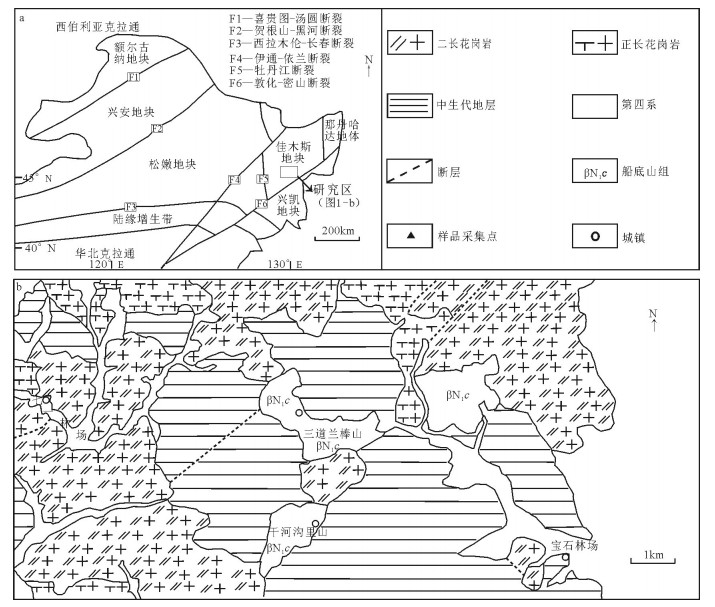
 下载:
下载:

